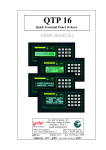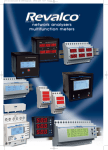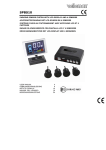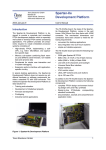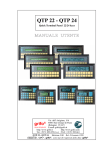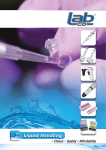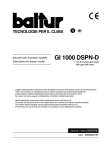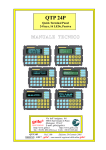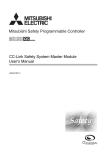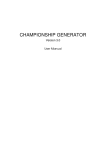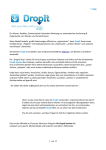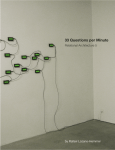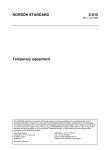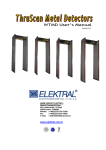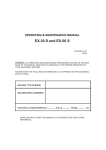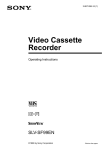Download QTP 22 - QTP 24
Transcript
QTP 22 - QTP 24 Quick Terminal Panel USER MANUAL Via dell' Artigiano, 8/6 40016 San Giorgio di Piano ® (Bologna) ITALY ITALIAN TECHNOLOGY Email: [email protected] http://www.grifo.it http://www.grifo.com Tel. +39 51 892.052 (a.r.) FAX +39 51 893.661 Edition 3.80 Rel. 05 February 1998 QTP 22/24 ® , GPC , grifo®, are trade marks of grifo® grifo QTP 22 - QTP 24 Quick Terminal Panel USER MANUAL QTP 24 Intelligent user panel equipped with Fluorescent 20x2 or 20x4 or LCD display, LEDs backlit, 20x2 or 20x4 characters; RS 232, RS 422-485 or Current Loop serial lines; serial EEPROM for set-up and messages; Possibility of re-naming keys, LEDs and panel name by inserting label with new name into the proper slot; 24 keys and 16 LEDs with blinking attribute and Buzzer manageable by software; built-in power supply; RTC option, reader of magnetic badge and relays. QTP 22 Intelligent user panel equipped with alphanumeric LCD display, LEDs backlit, 40x1, 40x2 or 40x4 characters or alphanumeric Fluorescent display 40x1, 40x2 or 40x4 characters; RS 232, RS 422-485 or Current Loop serial lines; serial EEPROM for set-up and messages; Possibility of re-naming the 22 keys and name panel by inserting label with new name into the proper slot; 22 LEDs with blinking attribute and Buzzer manageable by software; built-in 24 Vac power supply; RTC option, reader of magnetic badge and relays. Via dell' Artigiano, 8/6 40016 San Giorgio di Piano ® (Bologna) ITALY ITALIAN TECHNOLOGY Email: [email protected] http://www.grifo.it http://www.grifo.com Tel. +39 51 892.052 (a.r.) FAX +39 51 893.661 Edition 3.80 Rel. 05 February 1998 QTP 22/24 ® , GPC , grifo®, are trade marks of grifo® grifo DOCUMENTATION COPYRIGHT BY grifo® , ALL RIGHTS RESERVED. No part of this document may be reproduced, transmitted, transcribed, stored in a retrieval system, or translated into any language or computer language, in any form or by any means, either electronic, mechanical, magnetic, optical, chemical, manual, or otherwise, without the prior written consent of grifo®. QTP 22 - QTP 24 Quick Terminal Panel USER MANUAL IMPORTANT Although all the information contained herein have been carefully verified, grifo® assumes no responsibility for errors that might appear in this document, or for damage to things or persons resulting from technical errors, omission and improper use of this manual and of the related software and hardware. grifo® reservs the right to change the contents and form of this document, as well as the features and specification of its products at any time, without prior notice, to obtain always the best product. For specific informations on the components mounted on the card, please refer to the Data Book of the builder or second sources. SYMBOLS DESCRIPTION In the manual could appear the following symbols: Attention: Generic danger Attention: High voltage Trade Via dell'marks Artigiano, 8/6 ® 40016 San Giorgio ®di Piano , GPC®, grifo® : are trade (Bologna) marks of grifo . ITALY ITALIAN TECHNOLOGY Email: Other Product and Company names listed, [email protected] trade marks of their respective companies. http://www.grifo.it http://www.grifo.com Tel. +39 51 892.052 (a.r.) FAX +39 51 893.661 Edition 3.80 Rel. 05 February 1998 QTP 22/24 ® , GPC , grifo®, are trade marks of grifo® grifo grifo® ITALIAN TECHNOLOGY GENERAL INDEX INTRODUCTION ........................................................................................................................ 1 FIRMWARE RELEASE .............................................................................................................. 1 TERMINALS GENERAL FEATURES ..................................................................................... 2 BUZZER ..................................................................................................................................... 2 EEPROM .................................................................................................................................... 2 KEYBOARD .............................................................................................................................. 3 INDICATOR LEDS ................................................................................................................... 3 SERIAL COMMUNICATION ................................................................................................. 3 RELAYS ..................................................................................................................................... 3 REAL TIME CLOCK ............................................................................................................... 3 BADGE READER INTERFACE ............................................................................................. 3 ON BOARD POWER SUPPLY ............................................................................................... 3 QTP 24 TECHNICAL SPECIFICATIONS................................................................................ 4 GENERAL FEATURES............................................................................................................ 4 PHYSICAL FEATURES ........................................................................................................... 4 QTP 24 OVERALL SIZE ..................................................................................................... 5 ELECTRICAL FEATURES ..................................................................................................... 6 QTP 22TECHNICAL SPECIFICARTIONS ............................................................................. 8 GENERAL FEATURES............................................................................................................ 8 PHYSICAL FEATURES ........................................................................................................... 8 QTP 22 OVERALL SIZE ..................................................................................................... 9 ELECTRICAL FEATURES ................................................................................................... 10 TERMINALS INSTALLATION ............................................................................................... 13 QTP 24 POWER SUPPLY CONNECTOR. .......................................................................... 13 4 PINS CONNECTOR FOR QTP 24 SUPPLY ................................................................. 13 2 PINS CONNECTOR FOR QTP 24 A.C. SUPPLY ......................................................... 14 2 PINS CONNECTOR FOR QTP 24 D.C. SUPPLY ......................................................... 14 QTP 22 POWER SUPPLY CONNECTOR ........................................................................... 15 4 PINS CONNECTOR FOR QTP 22 SUPPLY ................................................................. 15 2 PINS CONNECTOR FOR QTP 22 A.C. SUPPLY ......................................................... 16 2 PINS CONNECTOR FOR QTP 22 D.C. SUPPLY ......................................................... 16 CONNECTOR FOR SERIAL COMMUNICATION........................................................... 17 RS 232 CONNECTION ....................................................................................................... 17 4 WIRES RS 422 CONNECTION ...................................................................................... 18 2 WIRES RS 485 CONNECTION ..................................................................................... 19 RS 485 MASTER-SLAVE COMMUNICATION NETWORK ........................................ 20 CURRENT LOOP CONNECTION .................................................................................... 21 CONNECTOR FOR RELAY CONNECTION ..................................................................... 23 CONNECTOR FOR CARD READER CONNECTION ..................................................... 24 MANUAL BADGE READER CONNECTION ................................................................. 24 MOTOR DRIVEN BADGE READER CONNECTION .................................................. 25 QTP 22/24 Rel. 3.80 Page I grifo® ITALIAN TECHNOLOGY SOFTWARE DESCRIPTION ................................................................................................... 26 LOCAL SETUP ....................................................................................................................... 26 MANAGING PROGRAM WITHOUT MASTER-SLAVE COMMUNICATION ........ 26 MANAGING PROGRAM WITH MASTER-SLAVE COMMUNICATION ................ 27 KEYBOARD ACQUISITION ................................................................................................ 27 QTP 24 TERMINAL KEYS MAP ...................................................................................... 28 KEYS DEFAULT CODES ON QTP 24 .............................................................................. 29 QTP 22 TERMINAL KEYS MAP ...................................................................................... 30 KEYS DEFAULT CODES ON QTP 22 .............................................................................. 31 CHARACTER VISUALIZATION ON THE DISPLAY ...................................................... 32 COMMANDS FOR CURSOR POSITIONING ................................................................... 32 CURSOR LEFT .................................................................................................................... 32 CURSOR RIGHT ................................................................................................................. 32 CURSOR DOWN ................................................................................................................. 32 CURSOR UP ......................................................................................................................... 33 HOME ................................................................................................................................... 33 CARRIAGE RETURN ........................................................................................................ 33 CARRIAGE RETURN+LINE FEED ................................................................................. 33 CURSOR ABSOLUTE POSITIONING WITH 20H OFFEST ........................................ 33 COMMANDS FOR CHARACTERS ERASURE ................................................................ 34 BACKSPACE ........................................................................................................................ 34 CLEAR PAGE ...................................................................................................................... 34 CLEAR LINE ....................................................................................................................... 34 CLEAR END OF LINE........................................................................................................ 34 CLEAR END OF PAGE ...................................................................................................... 34 COMMANDS FOR CURSOR ATTRIBUTES MANAGEMENT ...................................... 35 CURSOR OFF ...................................................................................................................... 35 STATIC CURSOR ON ......................................................................................................... 35 BLINKING "UNDERLINE"CURSOR ............................................................................. 35 BLINKING "BLOCK" CURSOR ...................................................................................... 35 COMMANDS FOR EEPROM MANAGEMENT ............................................................... 36 REQUEST FOR ON EEPROM WRITING..................................................................... 36 WRITING OF LIFE BYTE ................................................................................................ 36 READING OF LIFE BYTE ................................................................................................ 36 COMMANDS FOR LEDS MANAGEMENT ....................................................................... 37 LED ACTIVATION .............................................................................................................. 37 LEDS MASK ACTIVATION ............................................................................................... 37 LEDS MAP OF THE QTP 24 TERMINAL ....................................................................... 38 LEDS MAP OF THE QTP 22 TERMINAL ....................................................................... 39 COMMANDS FOR KEYBOARD MANAGEMENT .......................................................... 40 KEY RECONFIGURATION .............................................................................................. 40 KEYCLICK ON WITHOUT MEMORIZATION ............................................................ 40 KEYCLICK OFF WITHOUT MEMORIZATION .......................................................... 40 KEYCLICK ON WITH MEMORIZATION .................................................................... 41 KEYCLICK OFF WITH MEMORIZATION ................................................................... 41 COMMANDS FOR DIFFERENT FUNCTIONS ................................................................. 42 BEEP ...................................................................................................................................... 42 RELAY ACTIVATION ......................................................................................................... 42 RELAY DEACTIVATION ................................................................................................... 42 Page II QTP 22/24 Rel. 3.80 ITALIAN TECHNOLOGY grifo® READING OF VERSION NUMBER ................................................................................. 42 COMMANDS FOR MESSAGES MANAGEMENT ........................................................... 43 NUMBER READING OF THE LAST STORAGED MESSAGE ................................... 43 STORAGED MESSAGE .................................................................................................... 43 MESSAGE READING ......................................................................................................... 44 MESSAGES VISUALIZATION ......................................................................................... 44 MESSAGES VISUALIZATION IN SLIDING MODE..................................................... 45 COMMANDS FOR BADGE READER MANAGING ........................................................ 46 WRITING OF THE BADGE READER CONFIGURATION BYTE ............................. 46 READING OF THE BADGE READER CONFIGURATION BYTE ............................. 47 SINTAX OF THE STRING ACQUIRED BY THE BADGE READER .......................... 47 BADGE READER REQUEST OF THE ACQUIRED STRING ..................................... 48 ACQUISITION OF THE AUTOMATIC READER STATUS .......................................... 49 EXECUTION OF A NEW READING PROCEDURE ..................................................... 49 CARD EJECTION FROM AUTOMATIC READER ...................................................... 49 COMMAND FOR "EATING"THE CARD ....................................................................... 49 COMMANDS FOR MANAGING THE ON-BOARD REAL TIME CLOCK .................. 50 CLOCK SET-UP ................................................................................................................... 50 CLOCK READING .............................................................................................................. 50 WRITING OF A BYTE OF THE REAL TIME CLOCK RAM ..................................... 51 READING OF A BYTE OF THE REAL TIME CLOCK RAM ...................................... 51 TIME VISUALIZATION ON THE DISPLAY .................................................................. 51 DATE VISUALIZATION ON THE DISPLAY .................................................................. 52 QTP 22/QTP 24 COMMAND CODES SUMMARY TABLES ............................................ 53 MASTER-SLAVE COMMUNICATION MODE ................................................................. 56 APPENDIX A: DISPLAYS CHARACTERS TABLES ......................................................... A-1 APPENDIX B: QTP LABELS INSERTION ......................................................................... B-1 APPENDIX C: ALPHABETICAL INDEX ............................................................................ C-1 QTP 22/24 Rel. 3.80 Page III grifo® ITALIAN TECHNOLOGY FIGURE INDEX FIGURE 1: QTP 24 SIZE ................................................................................................................... 5 FIGURE 2: QTP 24 CONSUMPTION TABLE ......................................................................................... 6 FIGURE 3: QTP 24 PHOTO ............................................................................................................... 7 FIGURE 4: QTP 22 SIZE ................................................................................................................... 9 FIGURE 5: QTP 22 CONSUMPTION TABLE ....................................................................................... 10 FIGURE 6: QTP 22 PHOTO ............................................................................................................. 11 FIGURE 7: QTP 24 AND QTP 22 PANELS ....................................................................................... 12 FIGURE 8: 4 PINS CONNECTOR FOR QTP 24 SUPPLY ........................................................................ 13 FIGURE 9: 2 PINS CONNECTOR FOR QTP 24 A.C. SUPPLY ................................................................ 14 FIGURE 10: 2 PINS CONNECTOR FOR QTP 24 D.C. SUPPLY ............................................................. 14 FIGURE 11: 4 PINS CONNECTOR FOR QTP 22 SUPPLY ...................................................................... 15 FIGURE 12: 2 PINS CONNECTOR FOR QTP 22 A.C. SUPPLY .............................................................. 16 FIGURE 13: 2 PINS CONNECTOR FOR QTP 22 D.C. SUPPLY ............................................................. 16 FIGURE 14: RS 232 PIN-OUT AND POINT TO POINT CONNECTION EXAMPLE ..................................... 17 FIGURE 15: RS 422 PIN-OUT AND 4 WIRES CONNECTION EXAMPLE ................................................. 18 FIGURE 16: RS 485 PIN-OUT AND 2 WIRES CONNECTION EXAMPLE ................................................. 19 FIGURE 17: RS 485 NETWORK CONNECTION EXAMPLE ................................................................... 20 FIGURE 18: CURRENT LOOP PIN-OUT ............................................................................................ 21 FIGURE 19: 4 WIRES CURRENT LOOP POINT TO POINT CONNECTION EXAMPLE .......................... 22 FIGURE 20: 2 WIRES CURRENT LOOP POINT TO POINT CONNECTION EXAMPLE .......................... 22 FIGURE 21: QTP 24 RELAY CONNECTOR ..................................................................................... 23 FIGURE 22: QTP 22 RELAY CONNECTOR ..................................................................................... 23 FIGURE 23: QTP CONNECTOR FOR MANUAL CARD READER ................................................ 24 FIGURE 24: QTP CONNECTOR FOR MOTOR DRIVEN CARD READER ................................. 25 FIGURE 25: QTP 24 TERMINAL KEYS MAP ...................................................................................... 28 FIGURE 26: KEY DEFAULT CODES ON QTP 24 ................................................................................. 29 FIGURE 27: QTP 22 TERMINAL KEYS MAP ...................................................................................... 30 FIGURE 28: KEY DEFAULT CODES ON QTP 22 ................................................................................. 31 FIGURE 29: LEDS MAP OF THE QTP 24 TERMINAL ........................................................................ 38 FIGURE 30: LEDS MAP OF THE QTP 22 TERMINAL ........................................................................ 39 FIGURE 31: NUMBER OF MESSAGES STORAGEABLE ON EEPROM ................................................... 43 FIGURE 32: 7 BYTES FUNCTION FOR REAL TIME CLOCK SETTING .................................................... 50 FIGURE 33: COMMAND CODES SUMMARY: TABLE 1 ......................................................................... 53 FIGURE 34: COMMAND CODES SUMMARY: TABLE 2 ......................................................................... 54 FIGURE 35: COMMAND CODES SUMMARY: TABLE 3 ......................................................................... 55 FIGURE 36: LCD 20X2 CHARACTERS TABLE ................................................................................. A-1 FIGURE 37: LCD 20X4 AND 40X2 CHARACTERS TABLE ................................................................. A-2 FIGURE 38: LCD 40X1 AND 40X4 CHARACTERS TABLE ................................................................. A-3 FIGURE 39: FLUORESCENT 20X2 CHARACTERS TABLE .................................................................... A-4 FIGURE 40: FLUORESCENT 40X1 AND 40X2 CHARACTERS TABLE .................................................... A-5 FIGURE 41: FLUORESCENT 40X4 CHARACTERS TABLE .................................................................... A-6 FIGURE 42: FLUORESCENT 20X4 CHARACTERS TABLE .................................................................... A-7 FIGURE 43: QTP 24 LABELS SLOTS .............................................................................................. B-1 FIGURE 44: QTP 22 LABELS SLOTS .............................................................................................. B-2 Page IV QTP 22/24 Rel. 3.80 ITALIAN TECHNOLOGY grifo® INTRODUCTION The use of these devices has turned - IN EXCLUSIVE WAY - to specialized personnel. The purpose of this handbook is to give the necessary information to the cognizant and sure use of the products. They are the result of a continual and systematic elaboration of data and technical tests saved and validated from the Builder, related to the inside modes of certainty and quality of the information. The reported data are destined- IN EXCLUSIVE WAY- to specialized users, that can interact with the devices in safety conditions for the persons, for the machine and for the enviroment, impersonating an elementary diagnostic of breakdowns and of malfunction conditions by performing simple functional verify operations , in the height respect of the actual safety and health norms. The informations for the installation, the assemblage, the dismantlement, the handling, the adjustment, the reparation and the contingent accessories, devices etc. installation are destined - and then executable - always and in exclusive way from specialized warned and educated personnel, or directly from the TECHNICAL AUTHORIZED ASSISTANCE, in the height respect of the builder recommendations and the actual safety and health norms. The devices can't be used outside a box. The User must always insert the cards in a container that rispect the actual safety normative. The protection of this container is not threshold to the only atmospheric agents, but specially to mechanic, electric, magnetic, etc. ones. To be on good terms with the products, is necessary guarantee legibility and conservation of the manual, also for future references. In case of deterioration or more easily for technical updates, consult the AUTHORIZED TECHNICAL ASSISTANCE directly. To prevent problems during card utilization, it is a good practice to read carefully all the informations of this manual. After this reading, the User can use the general index and the alphabetical index, respectly at the begining and at the end of the manual, to find information in a faster and more easy way. FIRMWARE RELEASE This handbook make reference to firmware release 2.0 (standard version with µP 87c51), 5.8 (extended version with µP 87c52) and following ones. The validity of the information contained in this manual is subordinated to the firmware release number, so the user must always verify the correct correspondence beetween the notations. Inside the device, the firmware release number is written on the label stuck on the CPU or it can be obtained by a proper command sent through the serial line. QTP 22/24 Rel. 3.80 Page 1 grifo® ITALIAN TECHNOLOGY TERMINALS GENERAL FEATURES QTP 22 (Quick Terminal Panel-22 Keys) and QTP 24 (Quick Terminal Panel-24Keys) are complete operator panels, specifically designed for industrial use and for direct mounting on automatic machinery. They are, in every respect, video terminals suitable to be the direct interface between operator and machinery in any of the control or comand operations which could be necessary during running or diagnostic of the same. QTP are available with Fluorescent or LCD displays, backlite or not, 20x2 or 4 lines (QTP 24) or 40 characters for 1, 2 or 4 lines (QTP 22). The QTP affords 22 or 24 keys, with full user reconfiguration and name personalization slots labels identifying all or some keys. Some keys are provided with indicator LEDs, which can be switched on and off by dedicated commands received through the serial line. A third slot label can be used to carry a name for the QTP or the user’s own logo. The basic QTP can be expanded utilizing the various options available, namely EEPROM, up to 4 Kbyte capacity, Real Time Clock with 256 bytes user accessible RAM and Lithium backup battery, Actuating relay piloted through serial line, Acquisition from magnetic badge reader, Sundry communication protocols, Custom operating programs, etc. The QTP is able to execute an entire range of display commands, including Clear Screen, Position cursor, LED blink, etc., with code compatibility similar to that of the ADDS ViewPoint video terminal. Maximum specifications for the QTP are: - Surface or flush panel mounting - Mounting direct to Phoenix CombiCard® industrial instrument cases - Professional keypad: 22 keys and 22 LEDs (QTP22), or 24 keys and 16 LEDs (QTP24) - Complete user reconfiguration of key codes - Direct control of all indicator LEDs; blinking command on indicator LEDs - Name personalization slots label for keys; Panel name personalization slot - Alphanumeric display options afforded by Fluorescent or LCD - Buzzer programmable as BELL or to sound with keystroke - EEPROM for permanent storage of set-up, messages, key codes, etc. - Maximum possible EEPROM capacity 4 Kbytes - Option 1 A relay with changeover contacts, serially controlled - Option interface for magnetic strip badge reader - Option RTC with 256 bytes user-accessible RAM and Lithium backup battery - RS 232, RS 422-485 or Current Loop serial line; Local selection of Baud Rate - Internal power supply capable of driving external loads - DC or AC power supply from 5 Vdc to 24 Vac; Customized keyboard and program packages BUZZER QTP 22 and QTP 24 have a circuitery ables to emit a steady sound based on a capacitive buzzer. The said circuitery can be activated via software through a specific comand for generating a soundbeep or it can be linked to a key-pressure just to get the KeyClick function. EEPROM QTP 22 and QTP 24 have the on-board EEPROM (the capacity vary from 256Bytes to 4 KBytes) for memorizing set-up, keys code, communication protocole, name, messagges, and so on. It is possible to memorize up to 202 messages of 20 characters to be read in different moments or visualing them on the display just giving the identifying number of the message to the terminal. Page 2 QTP 22/24 Rel. 3.80 ITALIAN TECHNOLOGY grifo® KEYBOARD QTP 22 and QTP 24 have respectively a keyboard of 22 and 24 keys. These keys are equipped with AutoRepeat and they are totally software re-configurables as the code sent in RS 232 can be changed when a key is pressed. It is also possible to switch on/off the KeyClick function, i.e the Buzzer function each time a chosen key is pressed. Keyboards have user’s reconfigurable slots for keys rename; the QTP 22 has 22 re-naming keys while QTP 24 has 16 re-naming keys. INDICATOR LEDS QTP 22 and QTP 24 have indicator LEDs for different visual signals. On QTP 24 there are 16 LEDs and on QTP 22 there are 22 LEDs; all of them can also have the Blinking attribute as this function is totally autonomous and it doesn’t need any interventation on user part. The QTP 22 has LEDs linked to all its 22 keys while QTP 24 has 12 LEDs linked to keys and the remaining 4 keys are for user’s personalization. SERIAL COMMUNICATION The communication with remote units is by standard RS 232 serial line, but it can be optionally changed in RS 422-485 or Current Loop. 8 Bit protocole communication, NO PARITY, selectionable Baud Rate among 1200, 2400, 4800, 9600, 19200 and 38400 Baud. The local set program makes possible to set a number of 1 or 2 Stop bit. As option is available a communication protocole MasterSlave type with 9th bit tecnique and settable Baud-Rate at 187,5 Kbaud too. RELAYS QTP 22 and QTP 24 can have as option n.1 Relay equipped with 1 Ampere contact. This latter can be switched on / off via software directly by the user and it makes available, on the appropriate connector, the contact both normally open and normally closed. This option could be necessary when the automatic door opening must be directly controlled by using the terminal placed in the immediate closeness; in this case it will be necessary a power driven by the said relay. REAL TIME CLOCK QTP 22 and QTP 24 as option can have: Real Time Clock 256 Bytes of RAM at user disposal with Lithium battery data back-up. This device is manageable with appropriate software commands by the user and in this way it is possible to set time and date, to read these data or to have them on the display on a given position. There are also available two commands for writing and reading data from the on board RAM of the RTC. BADGE READER INTERFACE QTP 22 and QTP 24 as option can have a circuitery that allows to interface the terminal to a single track magnetic card reader which can be insertion or sliding types for reading the track n.1, 2 or 3. QTP 22 and QTP 24 automatically acquire the card and its decodification while the string is memorized into the local memory; in this way the user receives the message already decodified without being obliged to make further operations. ON BOARD POWER SUPPLY QTP 22 and QTP 24 have their own switch power supply so they can be powered with a voltage up to 24 Vac. As option, the 5Vdc voltage generated by this power supply, can be used to power small external loads directly from the terminal same. Take note that QTP 22 and QTP 24 instead of this switch power supply can also be supplied with a circuitery which allows to power the said terminals with a 5Vdc voltage. QTP 22/24 Rel. 3.80 Page 3 grifo® ITALIAN TECHNOLOGY QTP 24 TECHNICAL SPECIFICATIONS GENERAL FEATURES On board resources: - 16 LEDs, 4 of which are for user’s personalization and 12 coupled to keys. - 24 software reconfigurable keys 12 of which are for user’s personalization. - LCD Display (20 characters for 2 or 4 lines) backlite or not backlited, trimmer for contrast regulation; or Fluorescent Display ( 20 characters for 2 or 4 lines). - BUZZER for BELL signaling, or sound feed back when keys are pressed. -Full duplex RS 232 serial line or RS 422-485 or Current Loop. - EEPROM for set-up, messagges, keys codes and so on. 4 KBytes maximum. - Option RTC with 256 Bytes user-accessible RAM. - Option 1A Relay with Changeover contacts. - Various options among those ones there is also an interface for magnetic cards reader for single track. On board CPU: INTEL 87C51 with 14.7456 MHz Quartz INTEL 87C52 with 12MHZ Quartz (Option) Communicating protocole: Baud Rate: 1200, 2400, 4800, 9600, 19200 or 38400 Bauds. Option 187.5 Bauds. 1 or 2 Stop Bit. No Parity. 8 Bit (standard communication), 9 Bit ( Master-Slave communication). Option: settable communication in Master-Slave mode. Character size: Fluorescent 20x2: 5 x 7 dots, 2,25 x 4,16 mm (Horiz., Vertical) Fluorescent 20x4: 5 x 7 dots, 2,40 x 4,70 mm (Horiz., Vertical) LCD 20x2: 5 x 7 dots, 3,20 x 4,85 mm (Horiz., Vertical) LCD 20x4: 5 x 7 dots, 2,95 x 4,75 mm (Horiz., Vertical) PHYSICAL FEATURES Size: please refer to figure n. 1 Weight: 1000 grammes max. Mounting: On panel as Front-panel and Back-panel or direct mounting on Phoenix CombiCard industrial housings. Page 4 QTP 22/24 Rel. 3.80 grifo® ITALIAN TECHNOLOGY Connectors: CN1: 2-4 pins quick scew connector for power. CN2: 9 pins female D connector for serial connection. CN3: 3 pins quick screw connector for relays connection (Option). CN4: 10 pins connector for differents expansions such as Card reader (Option). Temperature range: from 0 to 50 °C. Relative humidity: 20% up to 90% (without condense) QTP 24 OVERALL SIZE Here is the QTP 24 size (in mm.) Rear view and lateral sides where connectors are located. This is not a scale drawing. 155 139 Breaking forINPUT Connectors 100 114,5 8 7 M4 172 26 14 31 185 FIGURE 1: QTP 24 SIZE QTP 22/24 Rel. 3.80 Page 5 grifo® ITALIAN TECHNOLOGY ELECTRICAL FEATURES Power voltage : 5Vdc or 8÷24Vac External loads power: 5Vdc (option) Power supply power: 7,5 W RS 422-485 Termination Network: pull-up resistor: pull-down resistor: line termination resistor: Absent Absent 120 Ω Hereunder islisted the QTP 24 consumption referred to the different versionswhich install different displays version. These consumptions are referred to the QTP 24 basic version with no options. Consumption LEDs Switched OFF DISPLAY Model Consumption LEDs Switched ON NOT Backlite LCD 50 mA - 5 Vdc 0.3 W - 8÷24 Vac 300 mA - 5 Vdc 1.9 W - 8÷24 Vac Backlite 20x2 LCD 200 mA - 5 Vdc 1.3 W - 8÷24 Vac 450 mA - 5 Vdc 2.8 W - 8÷24 Vac Backlite 20x4 LCD 250 mA - 5 Vdc 1.6 W - 8÷24 Vac 500 mA - 5 Vdc 3.1 W - 8÷24 Vac 20x2 Fluorerscent 295÷395 mA - 5 Vdc 1.8÷2.5 W - 8÷24 Vac 545÷645 mA - 5 Vdc 3.4÷4 W - 8÷24 Vac 20x4 Fluorerscent 380 mA - 5 Vdc 2.4 W - 8÷24 Vac 630 mA - 5 Vdc 4 W - 8÷24 Vac FIGURE 2: QTP 24 CONSUMPTION TABLE Page 6 QTP 22/24 Rel. 3.80 ITALIAN TECHNOLOGY grifo® FIGURE 3: QTP 24 PHOTO QTP 22/24 Rel. 3.80 Page 7 grifo® ITALIAN TECHNOLOGY QTP 22 TECHNICAL SPECIFICARTIONS GENERAL FEATURES On board resources: - 22 LEDs coupled to keys. - 22 software reconfigurable keys and available for user’s personalization. - LCD Display (40 characters for 1, 2 or 4 lines) backlite or not backlite, trimmer for contrast regulation; or Fluorescent Display ( 40 characters for 1,2 or 4lines). - BUZZER for BELL signaling, or sound feed back when keys are pressed. -Full duplex RS 232 serial line or RS 422-485 or Current Loop. - EEPROM for set-up, messagges, keys codes and so on. 4 KBytes maximum. - Option RTC with 256 Bytes user-accessible RAM. - Option 1A Relay with Changeover contacts. - Various options among those ones there is also an interface for magnetic cards reader for single track. On board CPU: INTEL 87C51 with 14.7456 MHz Quartz INTEL 87C52 with 12MHZ Quartz (Option) Communicating protocole: Baud Rate: 1200, 2400, 4800, 9600, 19200 or 38400 Bauds. Option 187.5 Bauds. 1 or 2 Stop Bit. No Parity. 8 Bit (standard communication), 9 Bit ( Master-Slave communication). Option: settable communication in Master-Slave mode. Character size: Fluorescent 40x1: Fluorescent 40x2: Fluorescent 40x4: LCD 40x1: LCD 40x2: LCD 40x4: 5 x 7 dots, 3,5 x 5,0 mm (Horiz., Vertical) 5 x 7 dots, 3,5 x 5,0 mm (Horiz., Vertical) 5 x 7 dots, 3,0 x 5,0 mm (Horiz., Vertical) 5 x 10 dots, 3,15 x 7,90 mm (Horiz., Vertical) 5 x 7 dots, 3,20 x 5,55 mm (Horiz., Vertical) 5 x 7 dots, 2,78 x 4,89 mm (Horiz., Vertical) PHYSICAL FEATURES Size: please refer to figure n. 4 Weight: 1800 grammes max. Mounting: On panels as Front-panel and Back-panel or direct mounting on Phoenix CombiCard industrial housings. Connectors: CN1: 2-4 pins 90° quick screw connector for power. CN2: 9 pins female D for serial connection. Page 8 QTP 22/24 Rel. 3.80 ITALIAN TECHNOLOGY grifo® CN3: 3 pins quick screw connector for relays connection (Option) CN4: 10 pins connector for differents expansions such as Card reader (Option). Temperature range: from 0 to 50 °C. Relative humidity: 20% up to 90% (without condense) QTP 22 OVERALL SIZE Here is the QTP 22 size (in mm.) Rear view and lateral sides where connectors are located. This is not a scale drawing. 256 Breaking for INPUT Connectors 139 100 113 6.5 6 M4 267.5 59 14 31 281 FIGURE 4: QTP 22 SIZE QTP 22/24 Rel. 3.80 Page 9 grifo® ITALIAN TECHNOLOGY ELECTRICAL FEATURES Power voltage: 5Vdc or 8÷24Vac External loads power: 5Vdc (Option) Power supply power: 12,5 W RS 422-485 Termination Network: pull-up resistor: pull-down resistor: line termination resistor: Absent Absent 120 Ω Hereunder islisted the QTP 22 consumption referred to the different versionswhich install different displays version. These consumptions are referred to the QTP 22 basic version with no options. DISPLAY Model Consumption LEDs Switched OFF Consumption LEDs Switched ON Not Backlite LCD 60 mA - 5 Vdc 0.4 W - 8÷24 Vac 400 mA - 5 Vdc 2.5 W - 8÷24 Vac Backlite 40x1 LCD 410 mA - 5 Vdc 2.6 W - 8÷24 Vac 750 mA - 5 Vdc 4.7 W - 8÷24 Vac Backlite 40x2 LCD 410 mA - 5 Vdc 2.6 W - 8÷24 Vac 750 mA - 5 Vdc 4.7 W - 8÷24 Vac Backlite 40x4 LCD 810 mA - 5 Vdc 5.1 W - 8÷24 Vac 1150 mA - 5 Vdc 7.2 W - 8÷24 Vac 40x1 Fluorescent 345÷495 mA - 5 Vdc 2.2÷3.1 W - 8÷24 Vac 585÷735 mA - 5 Vdc 3.7÷4.6 W - 8÷24 Vac 40x2 Fluorescent 795÷1045 mA - 5 Vdc 5÷6.5 W - 8÷24 Vac 1135÷1385 mA - 5 Vdc 7.1÷8.7 W - 8÷24 Vac 40x4 Fluorescent 1445÷2045 mA - 5 Vdc 9÷12 W - 8÷24 Vac 1785÷2385 mA - 5 Vdc 11÷14.9 W - 8÷24 Vac FIGURE 5: QTP 22 CONSUMPTION TABLE Page 10 QTP 22/24 Rel. 3.80 ITALIAN TECHNOLOGY grifo® FIGURE 6: QTP 22 PHOTO QTP 22/24 Rel. 3.80 Page 11 grifo® ITALIAN TECHNOLOGY grifo® QTP 24 1 5 ESC 2 6 3 7 9 0 4 8 ENTER grifo® QTP 22 FIGURE 7: QTP 24 AND QTP 22 PANELS Page 12 QTP 22/24 Rel. 3.80 grifo® ITALIAN TECHNOLOGY TERMINALS INSTALLATION This chapter illustrates all the operations which have to be done for the proper use of QTP 22 and QTP 24 terminals. These latter are provided with 4 connectors ( 2 of which are optional) for getting all the connections to the system. Here under please find the list of their Pin-Out and the meaning of the connected signals. QTP 24 POWER SUPPLY CONNECTOR. CN1 is a quick screw terminal connector having 2 or 4 pins as it is possible to get the 5Vdc generated by the on board switch power supply. The standard QTP 24 version is supplied with a 2 pins connector which is connected for giving a voltage of 8÷24Vac or +5Vdc to the card. Here is the rear view of the terminal where are shown the possible connector configurations. 4 PINS CONNECTOR FOR QTP24 SUPPLY +5 Vdc GND 8÷24 Vac FIGURE 8: 4 PINS CONNECTOR FOR QTP 24 SUPPLY Signals description: 8÷24 Vac = I - +5Vdc = O - GND = QTP 22/24 Rel. 3.80 Lines for QTP 24 powering through AC voltage connected to the onboard switch section. Output line for powering an external load through the on-board switch power supply. Ground line for external load supply. Page 13 grifo® ITALIAN TECHNOLOGY 2 PINS CONNECTOR FOR QTP 24 A.C. SUPPLY 8÷24 Vac FIGURE 9: 2 PINS CONNECTOR FOR QTP 24 A.C. SUPPLY Signals description: 8÷24 Vac = I - Lines for QTP 24 supply through Ac voltage connected to on-board switch 2 PINS CONNECTOR FOR QTP 24 D.C. SUPPLY +5 Vdc GND FIGURE 10: 2 PINS CONNECTOR FOR QTP 24 D.C. SUPPLY Signals description: +5Vdc GND Page 14 = = I - Line for QTP 24 supply through a +5Dc voltage. Ground line for QTP 24 supply. QTP 22/24 Rel. 3.80 grifo® ITALIAN TECHNOLOGY QTP 22 POWER SUPPLY CONNECTOR CN2 is a quick screw terminal connector having 2 or 4 pins as it is possible to get the 5Vdc generated by the on board switch power supply. The standard QTP 22 version is supplied with a 2 pins connector which is connected for giving a voltage of 8÷24Vac or +5Vdc to the card. Here are the possible configuration of the said connector . 4 PINS CONNECTOR FOR QTP22 SUPPLY + 5 Vdc GND 8÷24 Vac FIGURE 11: 4 PINS CONNECTOR FOR QTP 22 SUPPLY Signals description: 8÷24 Vac = I - +5Vdc = O - GND = QTP 22/24 Rel. 3.80 Lines for QTP 22 supply through AC voltage connected to the onboard switch section. Output line for powering an external load through the on-board switch power supply. Ground line for external load supply. Page 15 grifo® ITALIAN TECHNOLOGY 2 PINS CONNECTOR FOR QTP 22 A.C. SUPPLY 8÷24 Vac FIGURE 12: 2 PINS CONNECTOR FOR QTP 22 A.C. SUPPLY Signals description: 8÷24 Vac = I - Lines for QTP 22 supply through AC voltage connected to the onboard switch. 2 PINS CONNECTOR FOR QTP 22 D.C. SUPPLY + 5 Vdc GND FIGURE 13: 2 PINS CONNECTOR FOR QTP 22 D.C. SUPPLY Signals description: +5Vdc GND Page 16 = = I - Line for QTP 22 supply through a +5Dc voltage. Ground line for QTP 22 supply. QTP 22/24 Rel. 3.80 grifo® ITALIAN TECHNOLOGY CONNECTOR FOR SERIAL COMMUNICATION The connector for RS 232, RS 422-485 or Current Loop communication is CN2 on QTP 24 and CN3 on QTP 22; it is question of a 9 pins D female connector. Signals location has been carefully studied in order to reduce to the minimum level the interferences and making easier the connection to the field. RS232 CONNECTION 1 RxD TxD 6 2 7 3 8 4 9 RxD TxD TxD RxD GND GND 3 5 Master Remote System 5 2 9 Pin Connector CN2 QTP 24 / CN3 QTP 22 GND FIGURE 14: RS 232 PIN-OUT AND POINT TO POINT CONNECTION EXAMPLE Signals description: RxD = TxD = GND = I O QTP 22/24 - Receive Data. Transmit Data. Ground line. Rel. 3.80 Page 17 grifo® ITALIAN TECHNOLOGY 4 WIRES RS 422 CONNECTION RXRX+ TXTX+ GND 1 6 2 7 3 8 4 9 5 RX - TX - RX + TX + TX - RX - TX + RX + GND GND 2 3 4 Master Remote System 9 Pin Connector CN2 QTP 24 / CN3 QTP 22 1 5 FIGURE 15: RS 422 PIN-OUT AND 4 WIRES CONNECTION EXAMPLE Signals description: RX- = I - RX+ = I - TX- = O - TX+ = O - GND = Page 18 Receive Data Negative: negative bipolar line for 4 wires RS 422-485 diversity serial reception. Receive Data Positive: positive bipolar line for 4 wires RS 422-485 diversity serial reception. Transmit Data Negative: negative bipolar line for 4 wires RS 422-485 diversity serial reception. Transmit Data Positive: positive bipolar line for 4 wires RS 422-485 diversity serial reception. Ground line. QTP 22/24 Rel. 3.80 grifo® ITALIAN TECHNOLOGY 2 WIRES RS 485 CONNECTION TX / RXTX / RX+ 1 6 2 7 3 8 4 9 5 RX / TX - TX / RX - RX / TX + TX / RX + GND GND 1 2 5 Master Remote System 9 Pin Connector CN2 QTP 24 / CN3 QTP 22 GND FIGURE 16: RS 485 PIN-OUT AND 2 WIRES CONNECTION EXAMPLE Signals description: RX/TX - = I/O - RX/TX + = I/O - GND = Receive/Transmit Data Negative: negative bipolar line for diversity serial transmitting or receiving 2 wires RS 422-485. Receive/Transmit Data Positive: positive bipolar line for diversity serial transmitting or receiving 2 wires RS 422-485. Ground line. Note: Using this serial connection it is possible to get the 9 Bit Master-Slave communication mode only. QTP 22/24 Rel. 3.80 Page 19 grifo® ITALIAN TECHNOLOGY RS 485 MASTER-SLAVE COMMUNICATION NETWORK +5V 3.3 KΩ Slave 1 Master + + Tx/Rx 120 Ω Tx/Rx - 3.3 KΩ GND GND QTP 22/24 Unit Slave 2 + Tx/Rx GND Slave n 120 Ω + QTP 22/24 Unit Tx/Rx QTP 22/24 Unit GND FIGURE 17: RS 485 NETWORK CONNECTION EXAMPLE On the network line the user must connect a pull up and a pull down resistor (3,3 KΩ) because they are not present on QTP 22 and QTP 24 terminals. The user must also remember to connect at the communication line extremes, 2 line termination resistors (120 Ω) installed respectly near the Master unit and near the farthest Slave unit. The 120 Ω line termination resistor is already available on QTP 22 and QTP 24 and can be connected or not to the network with a dedicated jumper: QTP 22 J5 -> Connected (DEFAULT): The 120 Ω line termination resistor is connected to the RS 485 line. Not connected: The 120 Ω line termination resistor is not connected to the RS 485 line. QTP 24 J3 -> Connected (DEFAULT): The 120 Ω line termination resistor is connected to the RS 485 line. Not connected: The 120 Ω line termination resistor is not connected to the RS 485 line. For further info please refer to "RS 422 and RS 485 Interface Circuits" TEXAS INSTRUMENTS Data Book, pages for RS 422 and RS 485 NETWORK. Page 20 QTP 22/24 Rel. 3.80 grifo® ITALIAN TECHNOLOGY CURRENT LOOP CONNECTION 1 6 2 7 3 8 4 9 TX+ Curr. Loop TX- Curr. Loop RX+ Curr. Loop RX- Curr. Loop 5 FIGURE 18: CURRENT LOOP PIN-OUT Signals description: RX- Curr.Loop = I - RX+ Curr.Loop = I - TX- Curr.Loop = O - TX+ Curr.Loop = O - Receive Data Negative: negative bipolar line for Current Loop serial reception. Receive Data Positive: positive bipolar line for Current Loop serial reception. Transmit Data Negative: negative bipolar line for Current Loop serial transmission. Transmit Data Positive: positive bipolar line for Current Loop serial transmission. For Current Loop connection it is possible to get 2 differents type of connection: 2 and 4 wires. These kind of connections have been shown in the next two drawings where it is possible to see the voltage for VCL and the resistances for current limitation (R). The supply voltage vary in compliance with the number of the devices connected. When the maximum of current (20mA) runs it must be guaranted that each device dissipates at maximum 125mW for transmitter and 90mW for receiver. The R resistance is needed for limiting the maximum of current in case short circuit of the line. This is a 220 Ω resistance for a voltage of VCL=5Vdc. For further info please refer to HEWLETT-PACKARD Data Book, page for HCPL 4100 and 4200 devices. QTP 22/24 Rel. 3.80 Page 21 grifo® VCL + R TX + 9 9 Pin Connector CN2 QTP 24 / CN3 QTP 22 RX - RX + TX - 8 R TX - RX + 7 TX + RX - Master Remote System - ITALIAN TECHNOLOGY 6 FIGURE 19: 4 WIRES CURRENT LOOP POINT TO POINT CONNECTION EXAMPLE + R TX + 9 9 Pin Connector CN2 QTP 24 / CN3 QTP 22 RX - VCL RX + TX - TX - RX + TX + RX - 8 7 Master Remote System - 6 FIGURE 20: 2 WIRES CURRENT LOOP POINT TO POINT CONNECTION EXAMPLE Page 22 QTP 22/24 Rel. 3.80 grifo® ITALIAN TECHNOLOGY CONNECTOR FOR RELAY CONNECTION The connector for the on-board relay connection (option) is named CN3 on QTP 24 and CN4 on QTP 22. It is a 3 pins quick terminal connection; on it there are the following contacts : nomal open, normal close and commun of the Relay as shown in the drawings here under. QTP 24: rear side and QTP 22 profile view N.A. Comun N.C. FIGURE 21: QTP 24 RELAY CONNECTOR N.A. Comun N.C. FIGURE 22: QTP 22 RELAY CONNECTOR Signals description: Comun N.C. N.O. = = = QTP 22/24 Relay commun contact Relay contact normal closed Relay contact normal open Rel. 3.80 Page 23 grifo® ITALIAN TECHNOLOGY CONNECTOR FOR CARD READER CONNECTION This optional connector is a 10 pins 2.54 mm. type. It is named CN9 on QTP 22 and CN4 on QTP 24. Its pin-out depends from the card reader type (manual or motor driven) and below there is a description of the 2 different pin-outs: MANUAL BADGE READER CONNECTION OPEN 1 2 OPEN Switch 3 4 /RDP /RCP 5 6 /CPS OPEN 7 8 OPEN Vdc 9 10 GND FIGURE 23: QTP CONNECTOR FOR MANUAL CARD READER Signals description: OPEN /RDP /RCP = = = /CPS = SWITCH = Vdc GND Page 24 = = This pin must be necessary NOT CONNECTED. Pin to be connected to Read Data Pulse signal (data line), coming from the reader. Pin to be connected to the Read Clock Pulse signal (clock line), coming from the badge reader. Pin to be connected to the Card Presence signal, coming from the badge reader. This pin must be connected only if a manual insertion reader is used and in particular way this pin must be connected to N.O. contact of the switch (for this reader type only )as it indicates that the card is inserted even if partially. The COM contact of the said switch must be necessarly connect to the CND. +5Vdc voltage for badge reader supply. Ground line to be connected to the badge reader GND. QTP 22/24 Rel. 3.80 ITALIAN TECHNOLOGY grifo® MOTOR DRIVEN BADGE READER CONNECTION /MRS 1 2 /MFS /S1 3 4 /RDP /RCP 5 6 /S2 OPEN 7 8 OPEN OPEN 9 10 GND FIGURE 24: QTP CONNECTOR FOR MOTOR DRIVEN CARD READER Signals description: OPEN /MRS /MFS /RDP = = = = /RCP = /S1 = /S2 = GND = This pin must be necessary NOT CONNECTED. Pin to be connected to the Motor Reverse signal, coming from badge reader. Pin to be connected to the Motor Forward signal, coming from badge reader. Pin to be connected to Read Data Pulse signal (data line), coming from the badge reader and relative to the used track. Pin to be connected to the Read Clock Pulse signal (clock line), coming from the badge reader and relative to the used track. Pin to be connected to the Badge reader signal which is driven by the switch indicating that the card is inserted into its slot. Pin to be connected to the Badge reader signal which is driven by the switch indicating that the beginning edge of the card is lined up to the reading head Ground line to be connected to the badge reader GND. NOTE If the QTP is configured for the motor driven badge reader connection, the maximum EEPROM size is 2 Kbytes and the Real Time Clock can't be managed. QTP 22/24 Rel. 3.80 Page 25 grifo® ITALIAN TECHNOLOGY SOFTWARE DESCRIPTION As already said QTP 22 and QTP 24 terminals are complete video terminals and for this reason any thing received through serial line, if it is not question of a command, is shown on the display and codes of any pressed keys of the on-board keyboard, are transmitted to the control master unit . On board of these terminal panels is also implemented a local set-up program which allows to set the communication protocole by using the QTP’s keyboard and display. This manual contains, in addition to the description of the different functions, a complete list of the comand sequences and the recognized combination to be used to benefit of the main features of QTP 22 and QTP 24. For each code or codes sequence, there is a double description i.e: the mnemonic one through the ASCII characters and the numerical one under decimal and hexdecimal form. The said commands respect the ADDS View Point standard so all the sequences begin with ESC character corresponding to the 27 decimal code (1B Hex). LOCAL SETUP At this point the display shows the parameter set-up menu and LEDs referred to the keys used for modifying the parameters become active, more exactly it is necessary to act on keys n. 5 and n.6 as it will be lately illustrated. Take note that if QTP is equipped with the managing program for MasterSlave communication (Option) there will be a bigger number of option at your disposal and for this reason please refer to the paraghraph which refer to the managing program installed on the terminal same. MANAGING PROGRAM WITHOUT MASTER-SLAVE COMMUNICATION KEY n.5 : It allows to select the parameter to be modified displaying the following menu: "BAUD" (communication Baud Rate), "STOP" (Stop bits number) and "BEEP" (Keyclick function). KEY n.6: It allows to vary the value of the parameter previously selected with key n.5 and the following selections can be made: BAUD: STOP: BEEP: 38400, 19200, 9600, 4800, 2400 or 1200 Baud 1 (1 Stop bit) or 2 (2 Stop bits) ON (Keyclick On) or OFF (Keyclick Off) Once the set-up ends, pressing keys n. 0 and n.11 together, the parameters are memorized and it goes back to the standard function. Page 26 QTP 22/24 Rel. 3.80 ITALIAN TECHNOLOGY grifo® MANAGING PROGRAM WITH MASTER-SLAVE COMMUNICATION KEY n.5: It allows the selection of the parameter to be modified displaying the following menu: "COMMUNICATION" (communication type), "BAUD RATE" (communication baud rate), "STOP BIT" (Stop bits number), "KEYCLICK" (Keyclick function), "NAME" (first digit) and "NAME" (second digit). KEY n.6: It allows to vary the value of the parameter previously selected with key n.5 and the following selections can be made: COMMUNICATION: Standard or Master-Slave BAUD RATE: 187500, 38400, 19200, 9600, 4800, 2400 or 1200 Baud. STOP BIT: 1 or 2 with standard communication 1 with Masetr-Slave communication KEYCLICK: ON or OFF NAME: it modifies the figure from “>” and “<“ in the field 0÷F Hex Please note that the code that will be put in "NAME" , it will be the same to be used for identifying the QTP 22 or QTP 24 in Master-Slave communication. Once the set-up ends, if key n. 0 and n. 11 are pressed at the same moment, the parameters are memorized and it returns to the standard function. P.S. To this set-up program it is possible to enter only at the moment of the switch-on as, if keys n. 0 and n. 11 are pressed during standard QTP 22 and QTP 24 running no results will be achieved. KEYBOARD ACQUISITION When QTP 22 or QTP 24 recognizes the key pressure, it transmits the pertinent code in serial mode and this is immediate if standard communication is used. When Master-Slave communication is used, the said code is re-sent only upon specific request of the Master unit with the format illustrated in the specific paragraph. The AutoRepeat function of the pressed key is also implemented so when QTP recognizes the pressure on a specific key for a period of time over 0.5 sec. it will start the serial transmission of its code for about 0.2 sec. and it lasts until that specific key is left again. These two pictures show the keys numbering of QTP 22 and QTP 24 , then the two tables show the codes the terminal leaves again in serial mode after having pressed a key. As per the command sequences these ones are expressed under decimal form, hex-decimal and mnemonic formats by means of the specific characters of the ASCII table. QTP 22/24 Rel. 3.80 Page 27 grifo® ITALIAN TECHNOLOGY QTP 24 TERMINAL KEYS MAP N° 0 N° 1 N° 2 N° 3 N° 12 N° 13 N° 14 N° 21 N° 22 N° 15 grifo® N° 8 N° 4 N° 9 N° 5 N° 10 N° 6 N° 7 N° 11 N° 20 N° 16 N° 17 N° 18 N° 23 N° 19 FIGURE 25: QTP 24 TERMINAL KEYS MAP Page 28 QTP 22/24 Rel. 3.80 grifo® ITALIAN TECHNOLOGY KEYS DEFAULT CODES ON QTP 24 Here are the tables which show the codes that QTP 24 send in serial mode when a key is pressed; said codes are those ones listed under default condition i.e when no keys have been yet re-named. KEY N° CODE HEX CODE MNEMONIC 0 65 41 A 1 66 42 B 2 67 43 C 3 68 44 D 4 69 45 E 5 70 46 F 6 71 47 G 7 72 48 H 8 73 49 I 9 74 4A J 10 75 4B K 11 76 4C L 12 49 31 1 13 50 32 2 14 51 33 3 15 52 34 4 16 53 35 5 17 54 36 6 18 55 37 7 19 56 38 8 20 27 1B ESC 21 57 39 9 22 48 30 0 23 13 0D CR FIGURE 26: KEY DEFAULT CODES ON QTP 24 QTP 22/24 Rel. 3.80 Page 29 grifo® ITALIAN TECHNOLOGY QTP 22 TERMINAL KEYS MAP N° 1 N° 0 N° 3 N° 2 N° 5 N° 4 N° 7 N° 6 N° 9 N° 8 N° 10 grifo® N° 12 N° 11 N° 14 N° 13 N° 16 N° 15 N° 18 N° 17 N° 20 N° 19 N° 21 FIGURE 27: QTP 22 TERMINAL KEYS MAP Page 30 QTP 22/24 Rel. 3.80 grifo® ITALIAN TECHNOLOGY KEYS DEFAULT CODES ON QTP22 Here are the tables which show the codes that QTP 22 send in serial mode when a key is pressed; said codes are those ones listed under default condition i.e when no keys have been yet re-named. KEY N° CODE HEX CODE MNEMONIC 0 65 41 A 1 66 42 B 2 67 43 C 3 68 44 D 4 69 45 E 5 70 46 F 6 71 47 G 7 72 48 H 8 73 49 I 9 74 4A J 10 75 4B K 11 76 4C L 12 77 4D M 13 78 4E N 14 79 4F O 15 80 50 P 16 81 51 Q 17 82 52 R 18 83 53 S 19 84 54 T 20 85 55 U 21 86 56 V FIGURE 28: KEY DEFAULT CODES ON QTP 22 QTP 22/24 Rel. 3.80 Page 31 grifo® ITALIAN TECHNOLOGY CHARACTER VISUALIZATION ON THE DISPLAY QTP 22 and QTP 24 show on-board display all the characters having a code included in the range 32÷255 (20÷FF Hex); if it is sent a code not included in this range and this latter is not a command , this latter is ignored. The characters of the codes in the range 32÷127 (20÷7F Hex) correspond to those ones of the standard ASCII table, while characters associated to 128÷255 (80÷FF Hex) codes, vary depending on the type of the display installed. This is the reason why is better to refer to A Table. The character is visualized in the at-the moment cursor position and this latter will go the the next position; if it is placed in the last character down on the right of the display, it will be placed on Home position. COMANDS FOR CURSOR POSITIONING CURSOR LEFT Code: Mnemonic: 21 NACK (15Hex) The cursor is shifted of one position on the left without modifying the display contents. If the cursor is in Home position, it will be placed in the last character at the down-right position of the display. CURSOR RIGHT Code: Mnemonic: 06 ACK The cursor is shifted of one position on the right. If the cursor is placed on the last display character, down-right, il will be place on the Home position. CURSOR DOWN Code: Mnemonic: 10 LF (0A Hex) The cursor will be placed on the next line of that one it is now but it will remain in the same column. If the cursor is in the last display line, it will be placed at the first display line. Page 32 QTP 22/24 Rel. 3.80 grifo® ITALIAN TECHNOLOGY CURSOR UP Code: Mnemonic: 26 SUB (1A Hex) The cursor will be place din the previous line ot that one it is now, but it will remain in the same column. If the cursor is on the first display line, it will be place on the last display line. HOME Code: Mnemonic: 01 SOH The cursor is on Home position i.e first line, first column of the display. CARRIAGE RETURN Code: Mnemonic: 13 CR (0D Hex) The cursor is placed at the beginning of the line where it is. CARRIAGE RETURN+LINE FEED Code: Mnemonic: 29 GS (1D Hex) The cursor is placed at the beginning of next line at which it was placed. If the cursor is at the last display line, it will be placed at the beginning of the first line i.e Home position. CURSOR ABSOLUTE POSITIONING WITH 20H OFFEST Code: Mnemonic: 27 89 r c (1B 59 r c Hex) ESC Y ASCII(r) ASCII(c) The cursor is placed at the absolute point indicated through "r" and "c". These codes are referred to line and column values of the display at which the 32 (20 Hex) offset must be add. If, for example, you wish to place the cursor at Home position ( 0 line, 0 column) the next sequence is necessary 27 89 32 32. If line and column values are not compatible to the installed display, that command is ignored. QTP 22/24 Rel. 3.80 Page 33 grifo® ITALIAN TECHNOLOGY COMMANDS FOR CHARACTERS ERASURE BACKSPACE Code: Mnemonic: 08 BS The cursor shifts a character on the left by erasing the contents of the reached cell. If the cursor is at Home position, the character placed in the last cell, down- on the right of the display, will be erased. CLEAR PAGE Code: Mnemonic: 12 FF (0C Hex) Complete erasure of the display and the cursor returns to Home position. CLEAR LINE Code: Mnemonic: 25 EM (19 Hex) The complete line where cursor is placed is erased and then the cursor goes at the beginning of the said line. CLEAR END OF LINE Code: Mnemonic: 27 75 ESC K (1B 4B Hex) All characters on the line where the cursor is placed are erased starting from cursor position up to the end of the line. The cursor stays on the position as it was when Clear End of Line code arrives. If, for example, the cursor is at the beginning of a display line, the complete line will be erased. CLEAR END OF PAGE Code: Mnemonic: 27 107 ESC k (1B 6B Hex) All characters starting from the Cursor point up to the end of the display, are erased. The cursor stays in the same position as it was before the Clear end of Page code arrival. If, for example, the cursor is at Home position, the display will be completaly erased. Page 34 QTP 22/24 Rel. 3.80 grifo® ITALIAN TECHNOLOGY COMMANDS FOR CURSOR ATTRIBUTES MANAGEMENT CURSOR OFF Code: Mnemonic: 27 80 ESC P (1B 50Hex) The cursor is not active and it is not more visible. STATIC CURSOR ON Code: Mnemonic: 27 79 ESC O (1B 4F Hex) The cursor is started so it is visible. Now it is a not blinking line placed under the char. Note: this command is not available if Futaba 40x4 display is installed. BLINKING "UNDERLINE"CURSOR Code: Mnemonic: 27 77 ESC M (1B 4D Hex) The cursor is started so it is visible. Now it is a blinking line placed under the char. Note: This command is available only for Futaba displays : 20x2 and 40x1 type. BLINKING "BLOCK" CURSOR Code: Mnemonic: 27 81 ESC Q (1B 51 Hex) The cursor is started so it is visible. Now it is a blinking rectangular form and it is alternatively visualized with the char put on the same. Note: This command is available only for LCD displays otherwise is ignored QTP 22/24 Rel. 3.80 Page 35 grifo® ITALIAN TECHNOLOGY COMMANDS FOR EEPROM MANAGEMENT REQUEST FOR ON EEPROM WRITING Code: Mnemonic: 27 51 ESC 3 (1B 33 Hex) This command asks the card if it is ready for writing data on its on-board EEPROM. This command must be executed any time there are messages to be memorized ot some commands to be sent. 6 21 - 15 Hex (ACK) (NACK) QTP xx READY QTPxx NOT READY If the QTP send back the NACK code, it is not yet possible to memorize a new data on EEPROM. WRITING OF LIFE BYTE Code: Mnemonic: 27 33 78 key ( 1B 21 4E key Hex) ESC ! N ASCII (key) The “Life Byte” of the card is set with the value indicated in the “key” parameter, this parameter can be included in 0÷255 range. This byte has a reserved allocation on the on-board EEPROM that, once it is set with the value desired,it allows for example, to verify that QTP 22 or QTP 24 run correctly or if there are some communication problems on the serial line. Note: This command means a data writing on the on-board EEPROM, so before executing it is better to verify that the card is ready for the next writing on that device otherwise the command is ignored. READING OF LIFE BYTE Code: Mnemonic: 27 33 110 ESC ! " (1B 21 6E Hex) The QTP xx send back in serial mode the value of its “Life Byte”. This command can be useful if you have to verify the presence or the correct running of the card. Page 36 QTP 22/24 Rel. 3.80 grifo® ITALIAN TECHNOLOGY COMMANDS FOR LEDS MANAGEMENT LED ACTIVATION Code: Mnemonic: 27 50 n.LED Attr. (1B 32 n.LED Attr. Hex) ESC 2 ASCII(n.LED) ASCII(Attr.) The LED shown in “n.LED” with the specified attribute in “Attr.” is started. If you use the QTP 24 card LEDs numbers are included in a range of 0÷15 as shwon in the picture of the card, while for QTP 22 the LEDs numbers are included in a range of 0÷21. The attributes available aare as follows: 0 255 (FF Hex) 85 (55Hex) Not enabled LED Enabled LED Blinking LED ex. If you wish to enable LED n.5 with blinking attribute, the following sequence has to be sent: 27 50 5 85. If the parameter with LED number or that one with the attribute, it is not valid, the command is ignored. LEDS MASK ACTIVATION Code: Menomonic: 27 52 byte1 byte2 byte3 (1B 34 byte1 byte2 byte3 Hex) ESC 4 ASCII(byte1) ASCII(byte2) ASCII(byte3) All QTP 24 and QTP 22 LEDs are contemprarly managed as indicated in "byte1", "byte2" and "byte3" following this code: byte1 (bit 0...7) byte2 (bit 0...7) byte3 (bit0...5) LED 0...LED 7 LED 8...LED 15 LED 16...LED 21 (only for QTP 22) If a bit is placed in 0 position, the correpondent LED is OFF, viceversa it will be ON if the correspondent bit is on 1 position. If there are some LEDs having the blinking attribute, this latter will be desabled. P.S.: For QTP 24 the "byte3" must be always sent even if it has no meaning for running the 16 LEDs of the said terminal. QTP 22/24 Rel. 3.80 Page 37 grifo® ITALIAN TECHNOLOGY LEDS MAP OF THE QTP 24 TERMINAL LED 4 LED 5 LED 6 LED 7 LED 3 LED 0 LED 1 LED 2 grifo® LED 12 LED 13 LED 8 LED 14 LED 9 LED 15 LED 10 LED 11 FIGURE 29: LEDS MAP OF THE QTP 24 TERMINAL Page 38 QTP 22/24 Rel. 3.80 grifo® ITALIAN TECHNOLOGY LEDS MAP OF THE QTP 22 TERMINAL LED 2 LED 0 LED 6 LED 4 LED 10 LED 8 LED 14 LED 12 LED 18 LED 16 LED 20 grifo® LED 3 LED 1 LED 7 LED 5 LED 11 LED 9 LED 15 LED 13 LED 19 LED 17 LED 21 FIGURE 30: LEDS MAP OF THE QTP 22 TERMINAL QTP 22/24 Rel. 3.80 Page 39 grifo® ITALIAN TECHNOLOGY COMMANDS FOR KEYBOARD MANAGEMENT KEY RECONFIGURATION Code: Mnemonic: 27 55 key no. code (1B 37 key no. code Hex) ESC 7 ASCII( key no.) ASCII(code) When the selected key is reconfigured, each time it is pressed, the card will send the new specified code in serial mode. The number of the key to be reconfgured is obtainable by looking at the QTP picture and it must be included in a range of 0÷27 (0÷1B Hex) if this is not done the command is ignored. The code value can vary in a range of 0÷254 (0÷FE Hex) as the 255 value (FF Hex) indicates that the key must be desabled so when it is pressed the QTP will not send any codes in serial mode. P.S. The said command needs a data writing on the on-board EEPROM so before executing it, it is better to be sure that the card is ready for a new writing on such device otherwise the command will be ignored. KEYCLICK ON WITHOUT MEMORIZATION Code: Mnemonic: 27 54 ESC 5 (1B 35 Hex) The KeyClick function is switched-on so there is a sound feedback when a key is pressed. This parameter is not storaged in the on-board EEPROM so if the card is re-set it goes back to the previous condition. KEYCLICK OFF WITHOUT MEMORIZATION Code: Mnemonic: 27 54 ESC 6 (1B 36 Hex) The KeyClick function is desabled so there is not sound feedback when a key is pressed. This parameter is not storaged in the on-board EEPROM so if the card is re-set it goes back to the previous condition. Page 40 QTP 22/24 Rel. 3.80 grifo® ITALIAN TECHNOLOGY KEYCLICK ON WITH MEMORIZATION Code: Mnemonic: 27 33 53 ESC ! 5 (1B 21 35 Hex) The KeyClick function is switched-on so there is a sound feedback when a key is pressed. This parameter is storaged in the on-board EEPROM even if the power voltage fails. P.S. The said command involves a data writing on the on-board EEPROM so before executing it, it is better to be sure that the card is ready for a new writing on such device otherwise the command will be ignored. KEYCLICK OFF WITH MEMORIZATION Code: Mnemonic: 27 33 54 ESC ! 6 (1B 21 36 Hex) The KeyClick function is desabled so there is not sound feedback when a key is pressed. This parameter is storaged in the on-board EEPROM even if the power voltage fails. P.S. The said command needs a data writing on the on-board EEPROM so before executing it, it is better to be sure that the card is ready for a new writing on such device otherwise the command will be ignored. QTP 22/24 Rel. 3.80 Page 41 grifo® ITALIAN TECHNOLOGY COMMANDS FOR DIFFERENT FUNCTIONS BEEP Code: Menomonic: 07 BEL The buzzer is enabled for 1/10 second time RELAY ACTIVATION Code: Mnemonic: 27 56 ESC 8 (1B 38 Hex) The relay on the card, if any, is enabled and the normal open contact is shut (N.O.) and the normal shut contact is open (N.C.) RELAY DEACTIVATION Code: Mnemonic: 27 57 4 ESC 9 (1B 39 Hex) The relay on the card, if any, is desabled and the normal shut contact is shut (N.C.) and the normal open contact is open (N.O.) READING OF VERSION NUMBER Code: Mnemonic: 27 86 ESC V (1B 56 Hex) In serial mode is sent back a string of 3 char.containing the program managing version resident onboard of QTP 22 or QTP 24. Page 42 QTP 22/24 Rel. 3.80 grifo® ITALIAN TECHNOLOGY COMMANDS FOR MESSAGES MANAGEMENT NUMBER READING OF THE LAST STORAGED MESSAGE Code: Mnemonic: 27 110 ESC n (1B 6E Hex) The number of the last storaged message is sent back in serial mode; it varys in compliace with the EEPROM quantity installed on the card, please refer to the below table EEPROM SIZE MAX N. EEPROM SIZE MAX N. 256 Bytes 9 2304 Bytes 111 512 Bytes 22 2560 Bytes 124 2048 Bytes 99 4096 Bytes 201 FIGURE 31: NUMBER OF MESSAGES STORAGEABLE ON EEPROM STORAGED MESSAGE Code: Mnemonic: 27 33 67 mess.no. char. 0... char.19 (1B 21 43 mess.no. char. 0... char.13 Hex) ESC ! C ASCII(mess.no.) ASCII(char.0)...ASCII(char.19) The 20 char .message, with code indicated as “mess.no.” is stored in the on-board EEPROM. The 20 char. which form the message must be visualized on the display so thet are included in a range of 32÷255 (20÷FF Hex) otherwise the command is ignored. The message number must be included in the range of 0÷max. no., where “ max.no.” is the number of the last storaged message just previously described. P.S. This command needs a data writing in on-board EEPROM so before executing it be sure that the card is ready for the new writing on that device otherwise the command will be ignored. QTP 22/24 Rel. 3.80 Page 43 grifo® ITALIAN TECHNOLOGY MESSAGE READING Code: Mnemonic: 27 33 69 mess.no. (1B 21 45 mess.no. Hex) ESC ! E ASCII(mess.no.) The 20 char. message corresponding to “mess. no. it is read by the EEPROM and sent in serial mode beginning from the first char. of the string. At the end of the message, the CR+LF codes are sent but if the QTP is set for Master-Slave function the said codes are not more sent. The message number must be included in the range of 0÷max. no., where “ max.no.” is the number of the last storaged message just previously described. If this number is not compatible with the EEPROM quantity installed on the QTP, this command is ignored. MESSAGES VISUALIZATION Code: Mnemonic : 27 33 68 mess.no. n (1B 21 44 mess.no. ESC ! D ASCII(mess.no.) ASCII(n) n Hex) On the display “n.” 20 char.messages are visualized beginning from cursor position. The first of the “n” messages is that one having the code correspondng to ‘mess.no.” while the remaining messagges are those ones immediately subsequents in EEPROM. The number of “ mess.no” must be included in the range of 0÷max.no, where “max.no.” has the same meaning we have previously seen in figure n.31. If this number is not compatible with the EEPROM quantity installed on the QTP, this command is ignored. The “n” quantity of messages to be visualized depends only on the model of the display and it is included in these ranges: 20x2 or 40x1 Display 20x4 or 40x2 Display 40x4 Display n between 1÷2 n between 1÷4 n between 1÷8 If “n” value is not compatible with the model of the installed display, the command is ignored. The cursor is placed in the next cell of the last message visualized; if the last char. of the said message occupies the last position of the display, the cursor will be placed in Home position. For example; if you wish to visualize the message no. 20 and 21, it will be necessary to send the following sequence 27 33 68 20 2 to the card. P.S. Visualization of messages on Futaba displays, takes some time and it varys depending on the display size. Here there are some visualization time of a number of messages which occupy the whole Futaba display: 20x2 or 40x1 Display 20x4 or 40x2 Display 40x4 Display Page 44 (2 messages): (4 messages): ( 8 messages): 8 msec about 16 msec about 32 msec about QTP 22/24 Rel. 3.80 grifo® ITALIAN TECHNOLOGY MESSAGES VISUALIZATION IN SLIDING MODE Code: Mnemonic : 27 33 83 mess.no. n.char (1B 21 53 mess.no. n.char Hex) ESC ! S ASCII(mess.no.) ASCII(n.char) This command visualizes a "n.char" message on the display first line the characters appears in sliding mode. The message is shifted from right to left and so the user can visualize a very long string on the display. The string of "n.char" characters, begins with the first character of the "mess.no." message already stored in EEPROM. The “ mess.no” value must be included in the range 0÷max.no, where "max.no." has the same meaning described in figure n.31. If the value is out of range this command is ignored. The "n.char" parameter is used as follow: 0 20÷200 40÷200 -> -> -> Stops the message visualization in sliding mode. Sliding string length, when a 20 characters for line display is installed. Sliding string length, when a 40 characters for line display is installed. If "n.char." value is out of the specified ranges or it points after the last character stored in EEPROM, the command will be ignored. The message visualization in sliding mode is positioned on the first display line and the cursor position and attributes are held. For example, if you wish to visualize a 23 characters string in sliding mode, formed by the fifth message (i. e. 20 characters) and by the sixth message (3 characters) , it will be necessary to send the following sequence: 27 33 83 5 23. Note: The message visualization in sliding mode is managed in background and so there is a slowing down of serial data interpretation. This is the reason why it is necessary to wait for few msec between the transmission of 20÷30 bytes data blocks. In this way misunderstanding in interpreting the received data is completely void. QTP 22/24 Rel. 3.80 Page 45 grifo® ITALIAN TECHNOLOGY COMMANDS FOR BADGE READER MANAGEMENT QTP 22 and QTP 24 terminals are able to acquire single track magnetic badge readers. These latter can be both insertion and manual types, able to read track n.1 2 or 3. QTP by means of a specific command can be set in compliance with the badge reader at which it is connected. When QTP is configured to manage the automatic Badge Reader, it can manage 2 Kbytes of EEPROM max (instead of 4 Kbytes) and it can not manage the Real Time Clock. These last options are so installable on QTP 22 or QTP 24 only if these terminals do not manage the Badge Reader. When the card is inserted into the Automatic Badge Reader slot, the QTP automatically acquires the string there contained. More specifically the "forward motor" is activated until the card has been read and the followed string interpreted. If a mistake in reading occurs, other two attempts of acquisition will take place before declaring that string not valid; during this phase the "reverse motor" is activated in order to re-position the initial part of the card to be read for the new reading. Once the reading procedure is over, the result of such reading is memorized and, sent in serial mode as it happens when it is question of the manual badge reader. The card stays inside the badge reader until the ejection command is sent. The QTP has a further command that allows to "eat" the card; more exactly the "forward motor" is activated up to the card goes out from the back side of the reader. Just to have the card dropped into the little basket. This command is executed only when the flag of the configuration byte is abled. Here below there are the commands for managing such structures. WRITING OF THE BADGE READER CONFIGURATION BYTE Code: Mnemonic: 27 33 66 byte (1B 21 42 byte Hex) ESC ! B ASCII(byte) The byte with the parameters for Badge reader is storaged in the on-board EEPROM and kept there even if power voltage fails. Therefore QTP 22 or QTP 24 is re-configurable for the badge reader management in compliance with the parameters the said byte supplies: this configuration wil be restored each time the QTP will be powered and it will maintain this configuration until a new setting byte will be sent. The meaning of the said byte is as follows: Bit 0 -> 0 Bit 1 -> 1 0 1 Bit 2 -> Bit 3 -> 0 1 0 1 Page 46 The Badge reader connected to the QTP is of the Insertion Type (only if the reader is of manual insertion type, because if the reader is of automatic insertion type, this bit is ignored) The Badge reader connected to the QTP is of the Sliding Type The string memorized on to the magnetic card, it is acquired when this latter is during the insertion phase in the reader (only if the reader is of manual insertion type; when reader is manual or of the automatic insertion type, this bit is ignored). The string memorized on to the magnetic card is acquired when this latter is during the disinsertion phase from the reader. The Badge reader connected to the QTP reads Track 1 The Badge reader connected to the QTP reads Track 2 or 3 When a string is acquired from the Badge reader, this one is storaged and immediately sent in serial mode. This function is not available in Master-Slave mode. When a string is acquired from the Badge reader, this one is only storaged and sent in serial mode only when the QTP receives the specific command. QTP 22/24 Rel. 3.80 grifo® ITALIAN TECHNOLOGY Bit 4 -> 0 1 Bit 5 -> Bit 6 -> 0 1 0 1 Bit 7 -> 0 1 The magnetic card is inserted into the badge reader, starting from its beginning (only if the reader is of Manual Insertion Type, when the reader is of sliding or automatic type,this bit is ignored) The magnertic card is inserted into the Badge reader starting from its end. The badge reader is of Manual type. The badge reader is of Automatic type. Possibility of "EATING" the card ON (only if the reader is of automatic type, when the reader is of manual type this bit is ignored). Possibility of "EATING" the card OFF (only if the reader is of automatic type, when the reader is of manual type this bit is ignored). The badge reader management is ON The badge reader management is OFF When the management of the automatic badge reader is ON, the QTP will execute the inizialization of the device itself by acting the motor in a "Reverse mode" for abaut 0,5 seconds, just to eject a card may be kept inside. For example if you wish to configure the QTP for managing the Insertion Badge Reader which acquires the track 2 having the readingof the card during the disinsertion phase, it will be necessary to send the following sequence: 27 33 66 6 for getting a prompt response from QTP. If you send 27 33 66 14 the string acquired by QTP will be received only if QTP will be asked for it by using the specific command. P.S. This command needs a data writing in on-board EEPROM so before executing it be sure that the card is ready for the new writing on that device otherwise the command will be ignored. READING OF THE BADGE READER CONFIGURATION BYTE Code: Mnemonic: 27 33 98 ESC ! b (1B 21 62 Hex) The byte having the Badge reader configuration connected to the QTP 22 or QTP 24 is sent in serial mode. The meaning of this byte is the same one seen previously. By this command it is so possible to know in any moment what is the configuration of QTP 22 or QTP 24. SINTAX OF THE STRING ACQUIRED BY THE BADGE READER When the Badge reader acquires the magnetic card, the QTP 22 or QTP 24 storages the info coming fron this reading and if it is OK also the char. contained in the card. If the QTP is set for sending immediately via serial line these info ( Bit 3 of the set byte placed at 0 position) the following string will be transmitted: C2 Hex C2 Hex cod. char. no. char.1........char n 0D Hex 0A Hex The first two characters of the said string is C2 Hex code repeated twice; it is needed to indicate that the next info are pertinent to the Badge reader. It would be useful that this code is not associated QTP 22/24 Rel. 3.80 Page 47 grifo® ITALIAN TECHNOLOGY to any key of the QTP 22 or QTP 24 in order to avoid complication in recognizing the begginning of the answering string. If this association cann’t be avoided it is possible to discriminate the string answering from the badge reader, by checking the time break that elaps from the arrival of these codes. The third byte of the string is named cod. It contains the info concerning the result of the acquisition just performed, in particular way: Bit 7 -> 1 0 It shows that the saved info are transmitted for the first time. It shows that the saved info have been transmitted at least one time, therefore no additional magnetic cards have been acquired. The management of this bit is necessary because when a string is acquired by the badge reader through the specific command, it can be asked for various time so it is necessary to discriminate if the received answer concernes a new acquisition or it is question of a repetition of the previous one. Obviously, if the QTP is set for transmitting the answer immediately, during the first reception of the string autonomously transmitted by the terminal same, the result is that the said bit will be always at 1. Bits 0÷6 -> of cod. byte have on the contrary the following meaning: Bits 0÷6 -> 0 6 21 26 Into QTP memory none string availabe at present. A string valid and complete has been received. A string has been received but CRC is not correct or START char. is omitted. Valid string has been received but END char. is omitted. When manual insertion badge reader type is used, the string is considered valid only if START and END chars. have been indentified therefore the QTP is configuretd for such reader type and QTP will never send back the 26 code as the magnetic card must be always throughly acquired. If it is question of an insertion reader, it is possible to get a partial card acquisition; for this reason the string is considered valid even if the END char. is not identified. The forth byte of the answering string named n.char. contains the number of the chars. acquired by the magnetic card which will follow the answering string expect for the last chars. CR+LF. If the acquired string is not valid that byte will contain 0 value and it will be only followed by CR+LF codes. On the contrary if the magnetic card is correctly acquired, after the byte named n.car. ASCII codes of chars. contained in the card will follow between START and END codes. As said above the answering string will end with CR+LF codes. BADGE READER REQUEST OF THE ACQUIRED STRING Code: Mnemonic: 27 76 ESC L (1B 4C Hex) The answering string is sent via serial line with the sintax already described. If QTP 22 or QTP 24 is set for communicating in Master-Slave mode, the answering string will not count CR+LF chars. This command is available also when QTP is configured for sending the acquired string to the Badge reader. Page 48 QTP 22/24 Rel. 3.80 grifo® ITALIAN TECHNOLOGY ACQUISITION OF THE AUTOMATIC READER STATUS Code: Mnemonic: 27 67 ESC C (1B 43 Hex) A byte containig some status info (card inside, motor ON ect.) is sent back. This byte has the following values: 0 1 2 -> -> -> 3 -> 255 -> No card inside the badge reader and motor is OFF. The reader has a card inside and motor is OFF. No card inside and motor is ON. This code is sent back, for example, during the inizializing phase of the reader itself after a power-on of the QTP or while the card is "EATEN". The reader has a card inside and motor is ON. This code is sent back, for example, during the card reading or during insertion/ejection phases of the same. The badge reader is of manual type or the management of the card device is OFF. EXECUTION OF A NEW READING PROCEDURE Code: Mnemonic: 27 33 76 ESC ! L (1B 21 4C Hex) A new reading procedure of the card inside the automatic badge reader is executed. If there are other operations on the same device or the QTP is configured for the manual reader, this command is ignored. Note: Each card reading procedure include 3 attempts max, if a mistake in acquiring the same occurs. CARD EJECTION FROM AUTOMATIC READER Code: Mnemonic: 27 33 101 ESC ! e (1B 21 65 Hex) The ejection of the card inside the automatic badge reader is executed. This command is ignored when: a) no card inside the reader, b) other operations are taking place on the device, c) the QTP is configured for the manual reader. COMMAND FOR "EATING"THE CARD Code: Mnemonic: 27 33 84 ESC ! T (1B 21 54 Hex) The card inside the badge reader is "eaten" (it goes out from the back of the reader itself just to dropit into its basket). This operation is executed only if the corrispondent bit in the configuration byte is cleared (bit 6=0). This command is ignored when: a) no card inside the reader, b) other operations are taking place on the device, c) the QTP is configured for the manual reader. QTP 22/24 Rel. 3.80 Page 49 grifo® ITALIAN TECHNOLOGY COMMANDS FOR MANAGING THE ON-BOARD REAL TIME CLOCK CLOCK SET-UP Code: Mnemonic: 27 33 70 0 byte....6 byte (1B 21 46 ESC ! F ASCII ( 0 byte) .......ASCII(6 byte) 0 byte.....6 byte Hex) The on-board Real Time Clock is set with the data contained in the bytes named 0 byte ....6 byte; if one of these ones has a value included in the allowed range, the RTC allocation is not programmed. Here under is listed the meaning of the 7 bytes of above and their allowed range. BYTE RANGE FUNCTION 0 0 ... 23 HOURS 1 0 ... 59 MINUTES 2 0 ... 59 SECONDS 3 1 ... 31 DAY 4 1... 12 MONTH 5 0 ... 99 YEAR 6 0 ... 6 Week day: 0 -> SUNDAY ..... 6 -> SATURDAY FIGURE 32: 7 BYTES FUNCTION FOR REAL TIME CLOCK SETTING CLOCK READING Code: Mnemonic: 27 33 102 ESC ! f (1B 21 66 Hex) The 7 bytes named 0 byte ....7 byte are sent back via serial line with the date, time and day of the week which are drawn from the on-board Real Time Clock. The meaning of these bytes is the same listed in figure n.32. Page 50 QTP 22/24 Rel. 3.80 grifo® ITALIAN TECHNOLOGY WRITING OF A BYTE OF THE REAL TIME CLOCK RAM Code: Mnemonic: 27 33 71 addr byte (1B 21 47 addr byte Hex) ESC ! G ASCII(addre) ASCII(byte) On-board Real Time Clock RAM byte it is written with the value shown in "byte". The address where memorize the said byte is shown at "addr" and it must be included in the range 32...255 (20...FF Hex) otherwise the command is ignored. READING OF A BYTE OF THE REAL TIME CLOCK RAM Code: Mnemonic: 27 33 71 addr (1B 21 47 addr Hex) ESC ! g ASCII(addr) The on-board Real Time Clock RAM byte placed at the address shown at "addr" is sent back via serial line. This byte must be included in the range 32...255 (20..FF Hex) otherwise the command is ignored. TIME VISUALIZATION ON THE DISPLAY Code: Mnemonic: 27 33 116 r c frm (1B 21 74 r c frm Hex) ESC ! t ASCII(r) ASCII(c) ASCII(frm) The time drawn from the on-board Real Time Clock is displayed starting from the position shown by the "r" and "c" bytes. These codes express the raw and column values of the display at which an off set of 32 (20 Hex) must be added. If the raw and column values are not compatible to the display installed, this command will be ignored. The "frm" parameter is used to specify the visualization format, in particular way: Bit 0 -> 1 0 The time is visualized and automatically managed in "r", "c" position. The visualization of the time is interrupted. Bit 1 -> 1 The time is visualized in AM/PM format: HH:MM:SSm i.e.: HH (hours), MM ( minutes), SS (seconds), m (a=AM or p=PM). The time is visualized in 24H format: HH:MM:SS i.e.: HH (hours), MM ( minutes), SS (seconds). 0 Bit 2÷7 -> 0 Reserved for future expansion. They must be set to "0" value. For example, if you wish to visualize the time starting from Home position ( 0 raw, 0 column) and in 24 H format, it will be necessary to send the following sequence: 27 33 116 32 32 1. Note: The time drawn is managed in background and so there is a slowing down of serial data interpretation. This is the reason why it is necessary to wait for few msec between the transmission of 20÷30 bytes data blocks. In this way misunderstanding in interpreting the received data is completely void. QTP 22/24 Rel. 3.80 Page 51 grifo® ITALIAN TECHNOLOGY DATE VISUALIZATION ON THE DISPLAY Code: Mnemonic: 27 33 100 r c frm (1B 21 64 r c frm Hex) ESC ! d ASCII(r) ASCII(c) ASCII(frm) The date drawn from the on-board Real Time Clock is displayed starting from the position shown by the "r" and "c" bytes. These codes express the raw and column values of the display at which an off set of 32 (20 Hex) must be added. If the raw and column values are not compatible to the display installed, this command will be ignored. The "frm" parameter is used to specify the visualization format, in particular way: Bit 0 -> 1 0 The date is visualized and automatically managed in "r", "c" position. The visualization of the date is interrupted. Bit 1 -> 1 The format that visualizes the date is as follows: MM-DD-YY, i.e MM (month), DD (day), YY (year). The format that visualizes the date is as follows: DD-MM-YY, i.e DD (day), MM (month), YY (year). 0 Bit 2÷7 -> 0 Reserved for future expansion. They must be set to "0" value. Please note that the weerk day is not managed. For example, if you wish to visualize the date starting from Home position ( 0 raw, 0 column) and in MM-DD-YY format, it will be necessary to send the following sequence: 27 33 110 32 32 3. Note: Page 52 The date drawn is managed in background and so there is a slowing down of serial data interpretation. This is the reason why it is necessary to wait for few msec between the transmission of 20÷30 bytes data blocks. In this way misunderstanding in interpreting the received data is completely void. QTP 22/24 Rel. 3.80 grifo® ITALIAN TECHNOLOGY QTP 22/QTP 24 COMMAND CODES SUMMARY TABLES COMMAND CODE HEX CODE MNEMONIC HOME 01 01 SOH CURSOR LEFT 21 15 NACK CURSOR RIGHT 06 06 ACK CURSOR DOWN 10 0A LF CURSOR UP 26 1A SUB CARRIAGE RETURN 13 0D CR CR+LF 29 1D GS Cursor absolute positioning with 20H offset 27 89 r c 1B 59 r c ESC Y ASCII(r) ASCII(c) BACKSPACE 08 08 BS CLEAR PAGE 12 0C FF CLEAR LINE 25 19 EM CLEAR END OF LINE 27 75 1B 4B ESC K CLEAR END OF PAGE 27 107 1B 6B ESC k Cursor OFF 27 80 1B 50 ESC P Static cursor ON 27 79 1B 4F ESC O Blinking "Underline" cursor 27 77 1B 4D ESC M Blinking "Block" cursor 27 81 1B 51 ESC Q FIGURE 33: COMMAND CODES SUMMARY: TABLE 1 QTP 22/24 Rel. 3.80 Page 53 grifo® HEX CODE ITALIAN TECHNOLOGY COMMAND CODE MNEMONIC BEEP 07 07 BEL LED Activation 27 50 n.LED Attr. 1B 32 n.LED Attr. ESC 2 ASCII(n.LED) ASCII(Attr.) LEDs Mask Activation 27 52 byte1 byte2 byte3 1B 34 byte1 byte2 byte3 ESC 4 ASCII(byte1) ASCII(byte2) ASCII(byte3) Relay Activation 27 56 1B 38 ESC 8 Relay Deactivation 27 57 1B 39 ESC 9 Request for on EEPROM writing 27 51 1B 33 ESC 3 Writing of life byte 27 33 78 key 1B 21 4E key ESC ! N ASCII(key) Reading of life byte 27 33 110 1B 21 6E ESC ! n Characters show 32÷255 20÷FF “space”÷ASCII(255) Keyclick ON without memorization 27 53 1B 35 ESC 5 Keyclick OFF without memorization 27 54 1B 36 ESC 6 Key reconfiguration 27 55 n.Key cod. 1B 37 n.Key cod. ESC 7 ASCII(n.Key) ASCII(cod.) Keyclick ON with memorization 27 33 53 1B 21 35 ESC ! 5 Keyclick OFF with memorization 27 33 54 1B 21 36 ESC ! 6 Reading of version number 27 86 1B 56 ESC V FIGURE 34: COMMAND CODES SUMMARY: TABLE 2 Page 54 QTP 22/24 Rel. 3.80 grifo® ITALIAN TECHNOLOGY COMMAND CODE HEX CODE MNEMONIC Number reading of the last storaged message 27 110 1B 6E ESC n Storaged message 27 33 67 n.mess. char.0…char.19 1B 21 43 n.mess. char.0…char.13 ESC ! C ASCII(n.mess.) ASCII(char.0)…ASCII(char.19) Message reading 27 33 69 n.mess. 1B 21 45 n.mess. ESC ! E ASCII(n.mess.) Messages visualization 27 33 68 n.mess. n 1B 21 44 n.mess. n ESC ! D ASCII(n.mess.) ASCII(n) Messages visualization in sliding mode 27 33 83 n.mess. n.char. 1B 21 53 n.mess. n.char. ESC ! S ASCII(n.mess.) ASCII(n.char.) Writing of the Badge Reader configuration byte 27 33 66 byte 1B 21 42 byte ESC ! B ASCII(byte) Reading of the Badge Reader configuration byte 27 33 98 1B 21 62 ESC ! b Badge Reader request of the acquired string 27 76 1B 4C ESC L Acquisition of the automatic reader status 27 67 1B 43 ESC C Execution of a new reading procedure 27 33 76 1B 21 4C ESC ! L Card ejection from automatic reader 27 33 101 1B 21 65 ESC ! e Command for "EATING" the card 27 33 84 1B 21 54 ESC ! T Clock SET UP 27 33 70 “string” 1B 21 46 “string” ESC ! F ASCII(“string”) Clock reading 27 33 102 1B 21 66 ESC ! f Time visualization on the display 27 33 116 r c frm 1B 21 74 r c frm ESC ! t ASCII(r) ASCII(c) ASCII(frm) Date visualization on the display 27 33 100 r c frm 1B 21 64 r c frm ESC ! d ASCII(r) ASCII(c) ASCII(frm) Writing of a byte of the Real Time Clock RAM 27 33 71 addr byte 1B 21 47 addr byte ESC ! G ASCII(addr) ASCII(byte) FIGURE 35: COMMAND CODES SUMMARY: TABLE 3 QTP 22/24 Rel. 3.80 Page 55 grifo® ITALIAN TECHNOLOGY MASTER-SLAVE COMMUNICATION MODE The Master-Slave mode uses the 9 bits communication technique. In addition to the 8 data bit also a 9th bit is managed as it is needed for recognizing between a call coming from the "Master" to any of the "Slave" structures and a simple info transmission between Master and the selected device. When 9th bit is placed at 1, the data byte have to contain the name, or identifying code, of the device towards it needs to communicate, while by placing this particular bit at 0 position, it is possible to take out or supply with info at this device. As far as communications to QTP 22 and QTP 24, the identifying code must be that one set by the local Set up programm of the terminal itself. When this byte is sent ( with 9th bit placed at 1 position) the QTP xx recognizes itself and it waits the string containing chars., data or commands; this string must be of 25 bytes max. In this string there must only be a comand that involves the return of an information sent via serial line on QTP xx part; if there is an higher number, the remaining commands of these type are ignored. Between the transmission of a char. and the next one there must be an interval of time shorter than the Time-Out, as elapsed this delay, the QTP xx will consider the data string ended and it will begin the answering phase. Baud Rate 187500 38400 19200 9600 4800 2400 1200 Baud Baud Baud Baud Baud Baud Baud Time-Out 110 550 990 1540 3080 6105 12100 µsec µsec µsec µsec µsec µsec µsec When the Time-Out is over, the QTP xx begins the answering phase which consists in a byte containing the code of the pressed key (FF Hex, none key is pressed) or a data string related to a reading command sent in the previous request. For example if a string containing the reading command of the version is transmitted, we will get that for this particular request the pressed key code will be sent back, while in the next one the number of the required version previously asked for, will be transmitted . After that the last char. of the string has been transmitted to the QTP xx, it will be necessary to wait a time of: "char. transmission time" + Time-Out before reaching the first char. of the answering string transmitted by the QTP 22 or QTP 24. For example if we are working at 187.5 Baud, when the transmission of the last char. has been completed, it is necessary to wait for about 160 µsec, before completening the reception of the first answering byte on QTP xx part. Between a call and the next one, it is necessary to wait for a time that is related to the number of commands sent and type of operations these latter ones involve. Page 56 QTP 22/24 Rel. 3.80 ITALIAN TECHNOLOGY grifo® APPENDIX A: DISPLAYS CHARACTERS TABLES FIGURE 36: LCD 20X2 CHARACTERS TABLE QTP 22/24 Rel. 3.80 Page A-1 grifo® ITALIAN TECHNOLOGY FIGURE 37: LCD 20X4 AND 40X2 CHARACTERS TABLE Page A-2 QTP 22/24 Rel. 3.80 grifo® ITALIAN TECHNOLOGY FIGURE 38: LCD 40X1 AND 40X4 CHARACTERS TABLE QTP 22/24 Rel. 3.80 Page A-3 grifo® ITALIAN TECHNOLOGY FIGURE 39: FLUORESCENT 20X2 CHARACTERS TABLE Page A-4 QTP 22/24 Rel. 3.80 ITALIAN TECHNOLOGY grifo® FIGURE 40: FLUORESCENT 40X1 AND 40X2 CHARACTERS TABLE QTP 22/24 Rel. 3.80 Page A-5 grifo® ITALIAN TECHNOLOGY FIGURE 41: FLUORESCENT 40X4 CHARACTERS TABLE Page A-6 QTP 22/24 Rel. 3.80 grifo® ITALIAN TECHNOLOGY FIGURE 42: FLUORESCENT 20X4 CHARACTERS TABLE QTP 22/24 Rel. 3.80 Page A-7 grifo® Page A-8 ITALIAN TECHNOLOGY QTP 22/24 Rel. 3.80 ITALIAN TECHNOLOGY grifo® APPENDIX B: QTP LABELS INSERTION FIGURE 43: QTP 24 LABELS SLOTS Note: A) Unscrew the 4 black screws from the front panel. B) Take the panel out and unscrew the 8 screws and their grey plastic spacers which are placed in the back (do not take the printed corcuit out from the keyboard). C) Now the keyboard is ready for getting the 5 personalization labels (see figure 43). D) Remount the panel following the previous instructions but on the back-way. QTP 22/24 Rel. 3.80 Page B-1 grifo® ITALIAN TECHNOLOGY < FIGURE 44: QTP 22 LABELS SLOTS Note: A) Unscrew the 4 black screws from the front panel. B) Take the panel out and unscrew the 8 screws and their grey plastic spacers which are placed in the back (do not take the printed corcuit out from the keyboard). C) Now the keyboard is ready for getting the 2 personalization labels (see figure 44). D) Remount the panel following the previous instructions but on the back-way. E) The label indicated by the arrow is default inserted. Page B-2 QTP 22/24 Rel. 3.80 ITALIAN TECHNOLOGY grifo® APPENDICE C: ALPHABETICAL INDEX Simboli 2 WIRES RS 485 CONNECTION 19 2 WIRES CURRENT LOOP 22 4 WIRES RS 422 CONNECTION 18 4 WIRES CURRENT LOOP 22 A ACQUISITION OF THE AUTOMATIC READER STATUS ADDS View Point 2, 26 AutoRepeat 27 49 B Backlite 2 BACKSPACE 34 BADGE 46 BADGE READER 2, 46 BADGE READER INTERFACE 3 BADGE READER REQUEST OF THE ACQUIRED STRING Baud Rate 3, 4, 8, 27 BEEP 42 BELL 2 BLINKING "block" CURSOR 35 BLINKING "underline"CURSOR 35 BUZZER 2, 4, 8 48 C CARD EJECTION FROM AUTOMATIC READER 49 Cards reader 4, 8, 24, 25 CARRIAGE RETURN 33 CARRIAGE RETURN+LINE FEED 33 Character size 4, 8 CHARACTER VISUALIZATION ON THE DISPLAY 32 CLEAR END OF LINE 34 CLEAR END OF PAGE 34 CLEAR LINE 34 CLEAR PAGE 34 CLOCK READING 50 CLOCK SET-UP 50 COMANDS FOR CURSOR POSITIONING 32 COMMAND FOR "EATING"THE CARD 49 COMMANDS FOR BADGE READER MANAGING 45 COMMANDS FOR CHARACTERS ERASURE 34 COMMANDS FOR CURSOR ATTRIBUTES MANAGEMENT QTP 22/24 Rel. 3.80 35 Page C-1 grifo® ITALIAN TECHNOLOGY COMMANDS FOR DIFFERENT FUNCTIONS 42 COMMANDS FOR EEPROM MANAGEMENT 36 COMMANDS FOR KEYBOARD MANAGEMENT 40 COMMANDS FOR LEDs MANAGEMENT 37 COMMANDS FOR MANAGING THE ON-BOARD REAL TIME CLOCK 50 COMMANDS FOR MESSAGES MANAGEMENT 43 Communicating protocole 4, 8 CONNECTOR FOR CARD READER CONNECTION 24 CONNECTOR FOR RELAY CONNECTION 23 CONNECTOR FOR SERIAL COMMUNICATION 17 Connectors 5, 8 CN1 5, 8, 13 CN2 5, 8, 15, 17 CN3 5, 9, 17, 23 CN4 5, 9, 23, 24 CN9 24 CPU 4, 8 Current Loop 2, 3, 4, 8, 17, 21 CURRENT LOOP CONNECTION 21 CURSOR ABSOLUTE POSITIONING WITH 20H OFFEST 33 CURSOR DOWN 32 CURSOR LEFT 32 CURSOR OFF 35 CURSOR RIGHT 32 CURSOR UP 33 D DATE VISUALIZATION ON THE DISPLAY 52 E EEPROM 2, 3, 4, 8, 36, 43 EXECUTION OF A NEW READING PROCEDURE 49 External loads power 6, 10 F FIRMWARE RELEASE Fluorescent 2, 4, 8 1 H HOME 33 I INSTALLATION 13 Page C-2 QTP 22/24 Rel. 3.80 ITALIAN TECHNOLOGY grifo® K KEY 40 KEY RECONFIGURATION 40 KEYBOARD 27 KEYCLICK 3, 27, 40 KEYCLICK OFF WITH MEMORIZATION 41 KEYCLICK OFF WITHOUT MEMORIZATION 40 KEYCLICK ON WITH MEMORIZATION 41 KEYCLICK ON WITHOUT MEMORIZATION 40 Keys 2, 3, 4, 8 KEYS DEFAULT CODES ON QTP 24 29 KEYS DEFAULT CODES ON QTP22 31 L LCD 2, 4, 8 LED activation 37 LEDs 2, 3, 4, 8, 26, 37 LEDs MAP of the QTP 22 TERMINAL LEDs MAP of the QTP 24 TERMINAL LEDs MASK activation 37 Lithium 2 LOCAL SETUP 26 39 38 M MANAGING PROGRAMM WITH MASTER-SLAVE COMMUNICATION 27 MANAGING PROGRAMM WITHOUT MASTER-SLAVE COMMUNICATI 26 Manual BADGE reader connection 24 Master-Slave communication 4 Master-Slave communication 8, 19, 26, 56 MESSAGE READING 44 MESSAGES VISUALIZATION 44 MESSAGES VISUALIZATION in sliding mode 45 Motor driven BADGE reader connection 25 N NAME 27 Network 20 NUMBER READING OF THE LAST STORAGED MESSAGE 43 P Parity 3, 4, 8 Phoenix CombiCard 2, 4, 8 Power supply 2, 3, 13, 15 Power supply power 6, 10 Power voltage 6, 10 QTP 22/24 Rel. 3.80 Page C-3 grifo® ITALIAN TECHNOLOGY Q QTP 22 OVERALL SIZE 9 QTP 22 Consumption table 10 QTP 22 photo 11 QTP 22 POWER SUPPLY CONNECTOR 15 QTP 22 RELAY connector 23 QTP 22 size 9 QTP 22 TERMINAL KEYS MAP 30 QTP 24 OVERALL SIZE 5 QTP 24 and QTP 22 panels 12 QTP 24 Consumption table 6 QTP 24 photo 7 QTP 24 POWER SUPPLY CONNECTOR. 13 QTP 24 RELAY connector 23 QTP 24 size 5 QTP 24 TERMINAL KEYS MAP 28 R RAM 4, 8 READING OF LIFE BYTE 36 READING OF A BYTE OF THE REAL TIME CLOCK RAM 51 READING OF THE BADGE READER CONFIGURATION BYTE READING OF VERSION NUMBER 42 Real Time Clock 2, 3 Relative humidity 5, 9 Relay 4, 8, 23, 42 RELAY activation 42 RELAY deactivation 42 REQUEST FOR ON EEPROM WRITING 36 RS 232 2, 3, 4, 8, 17 RS 232 CONNECTION 17 RS 422-485 2, 3, 4, 8, 17, 18, 19 RS 422-485 Termination Network 6, 10 RS 485 MASTER-SLAVE COMMUNICATION NETWORK 20 RTC 2, 3, 4, 8, 50 47 S SETUP 26 SINTAX OF THE STRING ACQUIRED BY THE BADGE READER 47 Size 4, 8 Slots 2 STATIC CURSOR ON 35 Stop Bit 3, 4, 8, 27 STORAGED MESSAGE 43 Page C-4 QTP 22/24 Rel. 3.80 ITALIAN TECHNOLOGY grifo® T Temperature range 5, 9 TERMINALS 2 TERMINALS INSTALLATION 13 TIME VISUALIZATION ON THE DISPLAY 51 W Weight 4, 8 WRITING OF LIFE BYTE 36 WRITING OF THE BADGE READER configuration byte QTP 22/24 Rel. 3.80 46 Page C-5 grifo® Page C-6 ITALIAN TECHNOLOGY QTP 22/24 Rel. 3.80
















































































